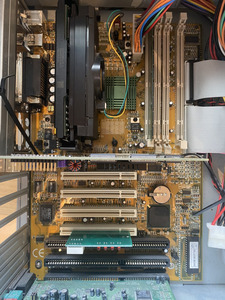First post, by cross
Hello everyone.
I recently pulled out a machine from storage to check on it a bit. P3 Machine with Full Yes INTEL 82440BX-S motherboard.
Noticed a weird issue that when the power is plugged in and PSU switched on, it looks like the standby voltage is "leaking" to various motherboard components.
So when the PSU is plugged in, I see that CPU fan is running (low speed), GPU fan running (low speed).
The same goes for plugging in a POST card in the PCI slot, the indicator leds on it is also lit, but dim. The same with the power LED on the front.
The machine power on and works as normal other than this.
It has been in storage for a while, I can not tell if it was like this before or something happened during storage.
The checks I have done so far is just to check that its not the PSU. It is behaving as normal, only supplying the VSB voltage until the PSON signal is present, where it starts up as normal.
I include a image of the motherboard for reference.
Any ideas on what can be the issue causing this? Any assistance is greatly appreciated!
